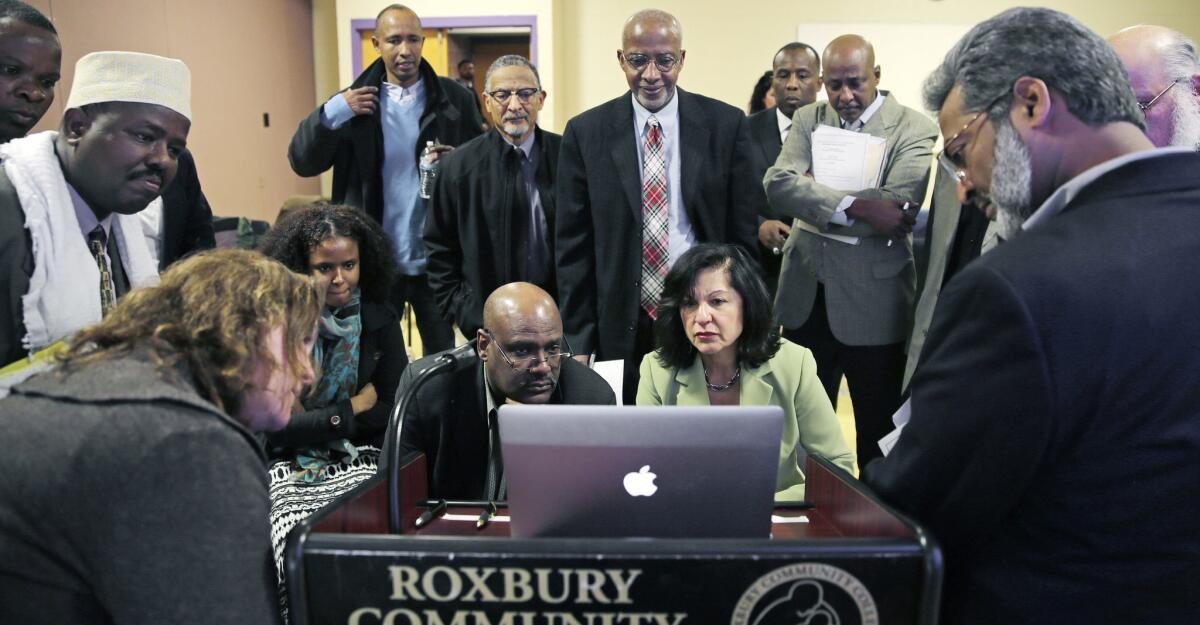Op-Ed: The U.S. government’s program to counter violent extremism needs an overhaul

- Share via
The Trump administration has indicated it plans to take the federal government’s Countering Violent Extremism program in a new direction. Media outlets report that it might be renamed the “Countering Islamic Extremism” program, or “Countering Radical Islamic Extremism.”
The current program, which seeks to deter potential attacks, certainly needs an overhaul. But not in the way the administration is suggesting.
The extremist threat in the United States is multifaceted, inspired by many violent ideologies. It is not a homogeneous threat from Muslim extremism. Neo-Nazis, Ku Klux Klan members, and so-called sovereign citizens, who violently reject the authority of the state — these and other extremists present a growing threat to the United States that must be addressed with purposeful engagement and study. A re-imagined Countering Violent Extremism program has an important part in that but not if it is narrowly focused on one ideology.
If the administration and Congress intend to reform the CVE program, they should consider where it has fallen short. The underlying concept is that by engaging community stakeholders in dialogue and sharing information about the risk of extremism and radicalization, we can develop strategies that prevent people from embracing ideologies that advocate violence. The beating heart of CVE is collaboration, but the current effort has actually dissuaded collaboration by stoking alienation.
Although the strategy is ostensibly designed to address any violent ideology, in practice it has focused primarily on the risk of extremism in Muslim communities.
Pilot programs have run in Los Angeles, Minneapolis and Boston, cities with Muslim communities and where distrust and animosity toward the CVE initiative has manifested.

In each of these cities, there has been pushback and protest, with many of the stakeholders who are essential to the CVE effort rejecting it, arguing that it targets and disparages Muslim communities.
As such, these trials have objectively failed, because they have cultivated community animosity rather than collaboration.
Going forward, there are several important points that should serve as guideposts as the CVE program is evaluated and improved.
1. Data providing evidence of potential threats should drive how and where the CVE effort is implemented. Muslim extremism is not the only terrorist threat. This is not a subjective matter of “political correctness,” but a fact backed by statistics. For example, according to the Anti-Defamation League, since 2009, there have been 77 shots fired in police confrontations with violent extremists; more than 80% of those were in clashes with white supremacists and antigovernment extremists.
2. There was a fundamental error in charging U.S. attorneys with managing the CVE pilots. A successful program cannot be run by the same arm of government that prosecutes terrorism cases. That demands an unrealistic level of trust on the part of the community. Why would someone participate in such an initiative if they fear their questions, comments and concerns could lead to an FBI agent knocking on their door? At best, the involvement of the Department of Justice sends a message that the intended collaboration is more about criminal justice than public safety. At worst, it raises legitimate suspicion that CVE is an avenue for detecting, arresting and prosecuting individuals who may be on the path to radicalization. The program should be purely focused on deterring extremism and the justice system should have a limited role, if any.
3. The CVE program needs to be led by the affected communities. Too often, federal employees seeking to address violent extremism parachute into a community and dictate public safety priorities to residents. This is akin to doing surgery before a physical exam. A federally led CVE program that tells a community what their safety concerns should be fails to cultivate the necessary buy-in because it runs counter to concerns people have on the local level.

What is needed is a “Mosaic of Engagement,” where the objective is for the community to identify the factors endangering public safety and forge consensus that reducing violent extremism is a desired byproduct of a safe community. By empowering the community to reach consensus, build lines of communication and identify local concerns, we can help create the social infrastructure needed to identify extremist threats and develop specifically local strategies to overcome them.
Now is the time to take a fresh look at the CVE effort and make thoughtful changes to the way it is managed and implemented. With data and genuine collaboration, we can prevent extremism and save lives. But if CVE becomes even more focused on Muslim extremism, it will exacerbate the problems that already exist and the program will certainly fail.
Dr. Erroll Southers is a former FBI special agent and currently director of Homegrown Violent Extremism Studies at the University of Southern California Sol Price School of Public Policy. He is author of the book “Homegrown Violent Extremism.”
Follow Southers on Twitter: @esouthersHVE
More to Read
A cure for the common opinion
Get thought-provoking perspectives with our weekly newsletter.
You may occasionally receive promotional content from the Los Angeles Times.










